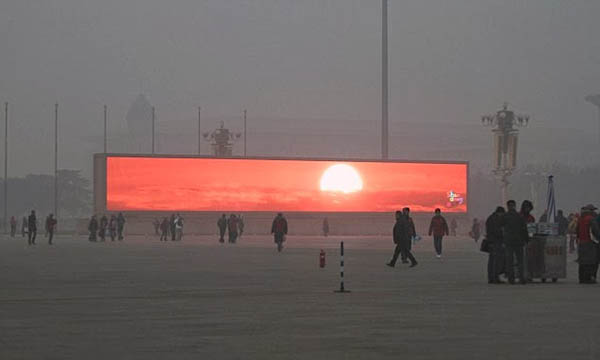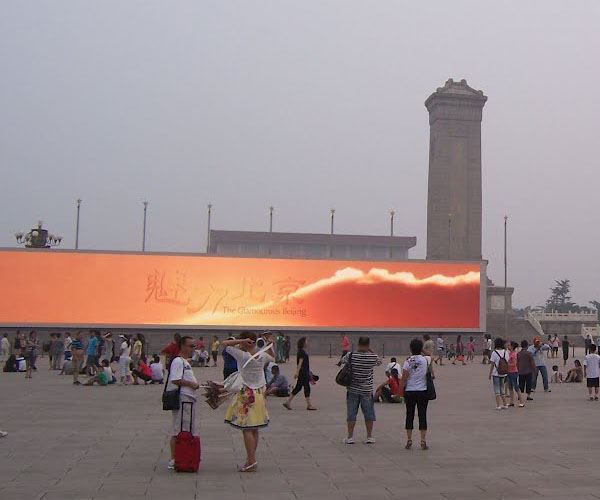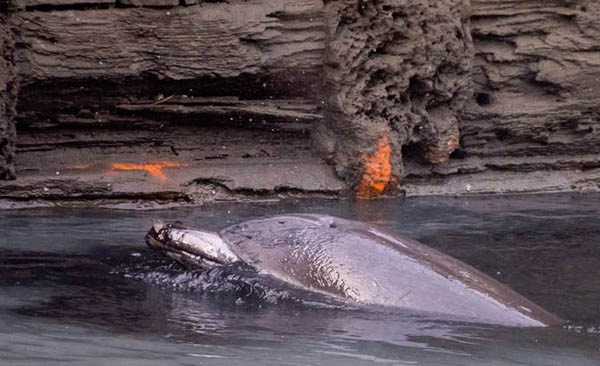Jump to the topic that is in the News |
||
Global Warming (coming) |
||
Fracking (coming) |
Renewable Energy (coming) |
|

Chinese citizens in Beijing enjoy doing Tai Chi to stay healthy, but the high air pollution levels made that almost impossible. The main culprit was smoke particles coming from coal power plants, automobiles, manufacturing plants, furnaces, and more.
Smoke particles fall under the classification of "particulates." The smaller the particulates the more easily they reach the depths of the lungs, which make them more dangerous. Particles smaller than 2.5 micrometers (also called microns, which is 1/1,000,000 of a meter) were the ones the city was most concerned about. They call these particles PM2.5, which is short for Particulate Matter 2.5 microns and smaller.
Unhealthy levels are 25 micrograms of PM2.5 particulates per cubic meter. In Beijing the level got close to 1000 micrograms per cubic meter. So it was 40 times greater than unhealthy. That's why the Chinese media had to talk about it despite the fact that normally criticizing pollution is not normally done because the blame usually falls on the government.


On the left is a photo of the city of Beijing. Some people say that there were times that you couldn't see the sun. Here is mostly blocked by the pollution.
Below are some of the headlines that were seen during January.
Beijing's Air Pollution Beyond 'Crazy Bad'
Beijing air pollution levels soar off the charts
Beijing Residents Scramble For Face Masks As Air Pollution Spikes To Dangerous Levels
Beijing announced more Restrictions for Cars to Curb pollution
Beijing's Pollution is Everyone's Problem

The schools kept children indoors and hospitals were seeing a 30 percent increase in people seeking help for respiratory problems.
Why did China let the pollution get this bad? Well it comes back to the point I made in the syllabus. When a society tries to solve a problem, it often creates a new one. China has been trying to solve their economic problem by ramping up mass production, which requires massive amount of energy and large numbers of vehicles to carry people and products to various locations. So the negative consequence of solving the economic problem is a new pollution problem.


United States went through the same phase of putting manufacturing ahead of health. On the left are photos of Pittsburg in the 1940's, which was typical for the city for 70 years. The below excerpts are from an online article at this URL:
"If a sheet of white paper lie upon your desk for half an hour you may write on it with your finger's end through the thin stratum of coal dust that has settled upon it during that interval."
"... this dirty power also happened to make a lot of people a lot of money. He whose hands are the most sooty handles the most money, and it is reasonable to infer is the richer man."
"Everyone knew that the smoke covering their homes and clothes and trees was bad. But it made a certain group of people a lot of money. And so they fought pollution controls."
"..wondered aloud whether corporations should be allowed to produce what it called such "evil," a Pittsburgh doctor maintained that soot and smoke "only go throat-deep" and said that fire and smoke "correct atmospheric impurities."
"...smoke not only is not unhealthy, but that it is an actual disinfectant..."
"...1,600,000 people of Chicago are divided into two classes--First, those who create a smoke nuisance; Second, those who are compelled to tolerate a smoke nuisance."
I'm amazed that some advocates of the pollution actually said that fire and smoke were not unhealthy and that smoke and fire actually disenfected the air and helped clean the air of some impurities. That's ridiculous. Bleach is a disenfectant, too, but that doesn't mean it's healthy to breathe.
Even today, the drive to make money still pushes companies and individuals to avoid the cost of neutralizing and containing pollutants. So even though it's not quite as obvious now as it was, it's still going on with many corporations. Many documentaries bring this to our attention.

Lab 1 is about the air we breathe. Read it to better understand the subject of air pollution. Here is the link:
http://www.chemistryland.com/CHM107Lab/Exp01_AirFilter/NewLab/Exp1Air.html

Below is excerpt from article from Liberty Voice, Jan. 18, 2014 (My comments in parentheses.)
Beijing Smog So Heavy City Resorts to Artificial Sunrises
In a scene like something out of a science fiction novel, the smog is so heavy in the city of Beijing, China that residents have taken to eagerly flocking around giant LED television screens broadcasting beautiful images of artificial sunrises because they can no longer see the real thing, thanks to heavy air pollution.
The screens, which are placed all around China’s capital city, are normally used to broadcast advertizements for tourist attractions, but they are now used to broadcast images of sunrises, a sight that residents can no longer view for themselves due to density of the air pollution in the city.

The electronic billboards also bear slogans such as one reminding residents that air quality is everyone’s responsibility. (Sadly, it's the manufacturing and coal fired boilers used for heating in large buildings that is the major source, not what the residents are responsible for.)
Beijing’s level of air pollution has reached dangerous levels. On Thursday, the air density reading was the highest it’s been since January 2013, with a measurement of 671 micrograms (per cubic meter).
(This screen is ironic saying, "The Glamorous Beijing" while the pollution is so high that glamorous is not the word you would use to describe it.)

Below is excerpt from article from CBS News, Jan.17, 2014
Smog-bound Beijing resorts to virtual sunrises
Like something out of a sci-fi novel from 50 years ago, residents of Beijing find themselves looking at alternative versions of a landscape they can't see anymore due to high levels of smog. High-tech screens placed around the city's capital, which advertise tourist attractions, also include virtual sunrises (and other clear sky images).
According to Reuters, Beijing saw the season's first wave of extremely dangerous pollution, with the concentration of toxic small particles registering more than two dozen times the level considered safe by the World Health Organization.
As a result, the sunlight-deprived city residents find themselves looking at images of what they once enjoyed naturally.



Below is an excerpt from The Brooklyn Paper with this article at: http://www.brooklynpaper.com/stories/36/5/all_dolphiningowanus_2013_02_01_bk.html
A dolphin that was trapped in the notoriously filthy and toxic Gowanus Canal is dead. Onlookers at the scene have reported the dolphin, which appeared to have an injured dorsal fin, died after spending nine sludge-covered hours in the disgusting waterway.
“He passed,” said Aida Rodriguez of Carroll Gardens. “There is no sign of life.”
The dolphin, which had been spotted swimming in the canal at 9:30 am, began bobbing up and down near the Union Street bridge between Bond and Nevins streets in the early afternoon, where dozens of concerned onlookers gathered in the freezing cold to catch a glimpse of the flailing dolphin.
The sludge-covered mammal was coming up for air every few seconds before it passed away at about 6 pm, breaking the hearts of animal-lovers who cheered the doomed creature from the banks of the canal.
“I have no words,” said Rodriguez who claimed she wanted to jump into the frigid waterway to save the creature. “This is just terrible,” she said as she broke down in tears. “It’s heartbreaking.”
Rodriguez said she believes that the crowd gave the dolphin a few extra breaths of life. “I think he knew he was surrounded by people who wanted to help him,” she said. “It gave him a bit of energy.”
Residents who ditched work to take see the sea creature for themselves said they were amazed by its presence in what could be considered a circle of hell.
“It’s an incredible sight,” said Tiffany Collings, who left her Park Slope clothing store job to check out the dolphin. “You don’t usually see a lot of wildlife in the Gowanus Canal.”
The common dolphin spotted swimming in the federal Superfund site — which is defined as a really dirty area— was an adult male estimated to be about six to seven feet long, weighing 200 to 250 pounds.
Rescue workers had hoped that the cetacean would somehow make its way back out to sea once high tide came in, and feared that any human help before then would only make matters worse.
“An intervention on our part can be detrimental to the animal,” said Julika Wocial, a marine biologist from the Riverhead Foundation, the rescue organization that received a call from a citizen who spotted the dolphin at the entrance to so-called “Lavender Lake” (named after the odd color it has from inks being dumped into it). The dolphin isn’t the first sea mammal to get caught — and die in — Brooklyn’s nautical purgatory.


Here's another story about the dolphin from the below website:
http://www.theblaze.com/stories/2013/01/25/wayward-dolphin-dies-after-being-stranded-polluted-nyc-canal/
Marine experts had hoped high tide, beginning around 7:10 p.m., would help the dolphin leave the canal safely. But the dolphin was confirmed dead shortly before then, said the Riverhead Foundation for Marine Research and Preservation, which didn’t know how it died.
Earlier, with the dolphin splashing around in the filthy water, bundled-up onlookers took cellphone photos, and a news helicopter hovered overhead.
The dolphin, which appeared to be about 7 feet long, surfaced periodically and shook black gunk from its snout in the polluted water.
The New York Police Department had said marine experts with the Riverhead Foundation had planned to help the dolphin on Saturday morning if it didn’t get out of the canal during high tide. The foundation, based in Riverhead, on eastern Long Island, specializes in cases involving whales, dolphins, seals and sea turtles.
The filthy canal was named a Superfund site in 2010, meaning the government can force polluters to pay for its restoration. For more than a century before, coal yards, chemical factories and fuel refineries on the canal’s banks discharged everything from tar to purple ink into the water, earning it the local nickname The Lavender Lake for its unnatural hue.
The dolphin likely entered the canal from the Atlantic Ocean through the Lower and Upper New York Bays and into the Gowanus Bay, which leads to the canal. It’s about 20 miles from the canal to open ocean.
It may seem strange, but it’s not uncommon for sea creatures to stray into city waters – though they don’t often swim away alive. A dolphin was found dead last August near Long Island, south of the canal. Another washed up in June in the Hudson River near Manhattan’s Chelsea Piers sports complex.
In 2007, a baby minke whale that briefly captivated the city wandered into the Gowanus Bay and swam aimlessly before dying.


On the left is a beautiful painting of Gowanus Bay in 1851. At that time a canal was proposed to allow water to drain the marshes and to create a waterway so that boats could navigate to inland industries. The canal was built in 1869. It was only 1.5 miles long but many businesses arose along its banks. Unfortunately, like the behavior of many businesses, the canal became a dumping place. It also dead-ended inland, so no fresh water would flow through it. Wikipedia has a good article on the Gowanus canal and its problems.
http://en.wikipedia.org/wiki/Gowanus_Canal
The bottom image is of the canal now, probably about 1/2 a mile from the top image. Again, we see pollution as a usual by-product of human activities, especially large scale industries. Industries are expected to have waste products. It's what they do with them is what matters. Many want to save money by dumping the waste so that present and future generations will have to deal with them. Fortunately, some industries will dispose of the waste responsibly or even figure out how to turn the waste into something that others can use. However, the Gowanus canal story is mostly of those who polluted the area from present time to 150 years ago. The Environmental Protection Agency has been fining some of the industries, but the vast majority will never pay anything for the cleanup-especially those who dumped decades ago and are no longer in business.